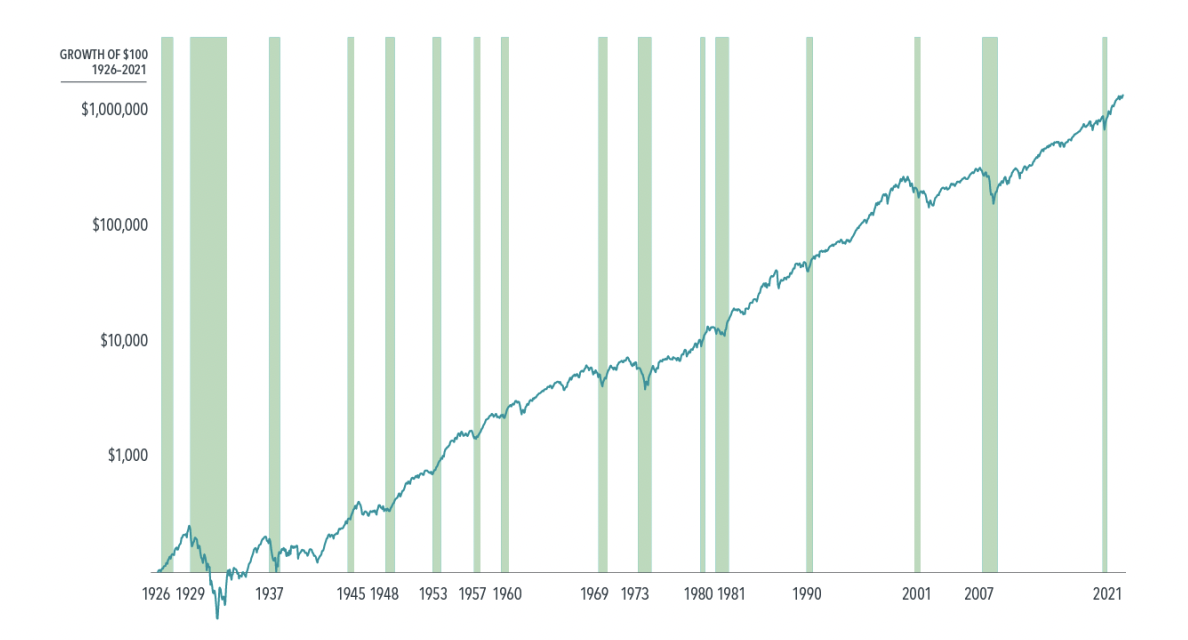Three Crucial Lessons for Weathering the Stock Market’s Storm
“History shows that stocks tend to outpace inflation over the long term.”
June 2022
Investors can always expect uncertainty. While volatile periods like the one we’re experiencing now can be intense, investors who learn to embrace uncertainty may often triumph in the long run. Reacting to down markets is a good way to derail progress made toward reaching your financial goals.
Here are three lessons to keep in mind during periods of volatility that can help you stick to your well-built plan.
A recession is not a reason to sell stocks
Time the market at your peril
It may be a good time to reassess your plan
1. A RECESSION IS NOT A REASON TO SELL STOCKS
Are we headed into a recession? A century of economic cycles teaches us we may well be in one before economists make that call.
But one of the best predictors of the economy is the stock market itself. Markets tend to fall in advance of recessions and start climbing earlier than the economy does. As the chart below shows, returns have often been positive while in a recession.
Exhibit 1
Growth of $100, 1926-2021
Recessions shaded in green.
Past performance is no guarantee of future results. Fama/French Total US Market Research Index, provided by Ken French and available at mba.tuck.dartmouth.edu/pages /faculty/ken.french/data_library.html
Whether accompanied by recessions or not, market downturns can be unsettling. But over the past century, US stocks have averaged positive returns over one-year, three-year, and five-year periods following a steep decline. A year after the S&P 500 crossed into bear market territory (a 20% fall from the market’s previous peak), it rebounded by about 20% on average. And after five years, the S&P 500 averaged returns over 70%.¹
Exhibit 2
Fama/French Total US Market Research Index Returns
July 1, 1926 - December 31, 2021
The bar chart shows the average returns for the 1-, 3-, and 5-year periods following the 10%, 20%, and 30% thresholds. Peak is a new all-time high prior to a downturn. Data provided by Fama/French. Source: Ken French website.
We believe that staying invested puts you in the best position to capture the recovery. We believe the only good reason to sell out of a stock portfolio now—so long as it’s diversified and low-cost—is because you learned something about your risk tolerance or your investment goals have changed.
2. TIME THE MARKET AT YOUR PERIL
When stocks have declined, it might be tempting to sell to stem further losses. You might think, “I’ll sit out until things get a bit better.” But by the time markets are less volatile, you’ll have often missed part of the recovery. Yes, it stings to watch your portfolio shrink, but imagine how you’ll feel when it’s stuck while the market rebounds.
If you invested $1,000 in the S&P 500 continuously from the beginning of 1990 through the end of 2020, you would have $20,400. If you missed the single best day, you’d only have $18,300—and only $12,900 if you missed the best five days.²
History shows the stock market tends to rebound quickly. The same can’t be said for individual stocks or even entire sectors. Diversification is a top risk mitigation tool, along with investing in fixed income and having a financial plan.
3. IT MAY BE A GOOD TIME TO REASSESS YOUR YOUR PLAN
Do you know the names of all the stocks you own? Then you probably own too few. How much of your portfolio sits outside the US? Because about half the global market is comprised of foreign stocks. If you only invest in the S&P 500, you’re missing half of the investment opportunity set. A market-cap-weighted global portfolio is a better starting point than chasing segments of the market that have outperformed in the past few years.
And if you want to outperform the market, allow decades of academic research to light the way. Portfolios focused on small caps, value stocks, and more profitable companies have had higher returns over the long run.
Beyond a well-designed portfolio, one of the best ways to deal with volatile markets and disappointing returns is to have planned for them. A financial advisor can help you develop a plan that bakes in the chances you’ll experience some market lows.
A sound approach to investing—through a plan, a well-designed portfolio, and an advisor—is the ultimate self-care during these rough markets. Your future self will thank you.
FOOTNOTES
S&P data © 2022 S&P Dow Jones Indices LLC, a division of S&P Global. All rights reserved. Indices are not available for direct investment.
Past performance, including hypothetical performance, is no guarantee of future results. Growth of $1,000 is hypothetical and assumes reinvestment of income and no transaction costs or taxes. The analysis is for illustrative purposes only and is not indicative of any investment. S&P data © 2022 S&P Dow Jones Indices LLC, a division of S&P Global. All rights reserved. Indices are not available for direct investment.



